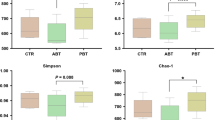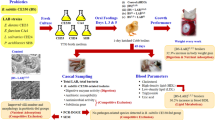Abstract
This study was to investigate the effects of live or autoclaved Bacillus subtilis natto, their fermented products and media on rumen fermentation and rumen functional bacteria in vitro. Rumen fluid from three multiparous lactating Holstein cows was combined and transferred into serum bottles after diluted. Fifteen serum bottles were divided into five treatments, which were designed as following: CTR (the fermentation of 0.5 g TMR and ruminal fluids from dairy cows), LBS (CTR plus a minimum of 1011 cfu live Bacillus subtilis natto), ABS (CTR plus a minimum of 1011 cfu autoclaved Bacillus subtilis natto), BSC (CTR plus 1 ml Bacillus subtilis natto fermentation products without bacteria), and BSM (CTR plus 1 ml liquid fermentation medium). When separated from the culture, live Bacillus subtilis natto individually increased the concentrations of ammonia-N (P < 0.01), MCP production (P < 0.01), and tended to elevate total VFA (P = 0.07), but decreased the ratio of acetate and propionate (P < 0.01). Autoclaved Bacillus subtilis natto has the similar function with the live bacteria except for the ratio of acetate and propionate. Except B. fibrisolvens, live or autoclaved Bacillus subtilis natto did not influence or decreased the 16S rRNA gene quantification of the detected bacteria. BSC and BSM altered the relative expression of certain functional bacteria in the rumen. These results indicated that it was Bacillus subtilis natto thalli that played the important role in promoting rumen fermentation when applied as a probiotic in dairy ration.
Similar content being viewed by others
References
Barnes AGC, Cerovic V, Hobson PS, Klavinskis LS (2007) Bacillus subtilis spores: a novel microparticle adjuvant which can instruct a balanced Th1 and Th2 immune response to specific antigen. Eur J Immunol 37:1538–1547
Broderick GA, Kang JH (1980) Automated simultaneous determination of ammonia and total amino acids in ruminal fluid and in vitro media. J Dairy Sci 63:64–75
Casula G, Cutting SM (2002) Bacillus probiotics: spore germination in the gastrointestinal tract. Appl Environ Microbiol 68:2344–2352
Chen KL, Kho WL, You SH, Yeh RH, Tang SW, Hsieh CW (2009) Effects of Bacillus subtilis var. natto and Saccharomyces cerevisiae mixed fermented feed on the enhanced growth performance of broilers. Poult Sci 88:309–315
Denman SE, McSweeney CS (2006) Development of a real-time PCR assay for monitoring anaerobic fungal and cellulolytic bacterial populations within the rumen. FEMS Microbiol Ecol 58:572–582
Esawy MA, Ahmed EF, Helmy WA, Mansour NM, El-Senousy WM, El-Safty MM (2011) Production of levansucrase from novel honey Bacillus subtilis isolates capable of producing antiviral levans. Carbohyd Polym 86:823–830
Fujiwara K, Yamazaki M, Abe H, Nakashima K, Yakabe Y, Otsuka M, Ohbayashi Y, Kato Y, Namai K, Toyoda A, Miyaguchi Y, Nakamura Y (2009) Effect of Bacillus subtilis var. natto fermented soybean on growth performance, microbial activity in the caeca and cytokine gene expression of domestic meat type chickens. J Poult Sci 46:116–122
Ghorbani GR, Morgavi DP, Beauchemin KA, Leedle JAZ (2002) Effects of bacterial direct-fed microbials on ruminal fermentation, blood variables, and the microbial populations of feedlot cattle. J Anim Sci 80:1977–1985
Hong HA, Duc LH, Cutting SM (2005) The use of bacterial spore formers as probiotics. FEMS Microbiol Rev 29:813–835
Hu WL, Liu JX, Ye JA, Wu YM, Guo YQ (2005) Effect of tea saponin on rumen fermentation in vitro. Anim Feed Sci Technol 120:333–339
Hyronimus B, Le Marrec C, Hadj Sassi A, Deschamps A (2000) Acid and bile tolerance of spore-forming lactic acid bacteria. Int J Food Microbiol 61:193–197
Jenny BF, Vandijk HJ, Collins JA (1991) Performance and fecal flora of calves fed a Bacillus subtilis concentrate. J Dairy Sci 74:1968–1973
Kang ZH, Dong JG, Zhang JL (2012) Optimization and characterization of nicosulfuron-degrading enzyme from Bacillus subtilis strain YB1. J Integr Agric 11:1485–1492
Koike S, Kobayashi Y (2001) Development and use of competitive PCR assays for the rumen cellulolytic bacteria: Fibrobacter succinogenes, Ruminococcus albus and Ruminococcus flavefaciens. FEMS microbial Lett 204:361–366
Kritas SK, Morrison RB (2005) Evaluation of probiotics as a substitute for antibiotics in a large pig nursery. Vet Rec 156:447–448
Kubo Y, Inaoka T, Hachiya T, Miyake M, Hase S, Nakagawa R, Hasegawa H, Funane K, Sakakibara Y, Kimura K (2013) Development of a rifampicin-resistant Bacillus subtilis strain for natto-fermentation showing enhanced exoenzyme production. J Biosci Bioeng 115:654–657
Livak KJ, Schmittgen TD (2001) Analysis of relative gene expression data using real-time quantitative PCR and the 2−△△CT method. Methods 25:402–408
Makkar HPS, Becker K (1999) Purine quantification in digesta from ruminants by spectrophotometric and HPLC methods. Br J Nutr 81:107–113
Menke KH, Steingass H (1988) Estimation of the energetic feed value obtained by chemical analysis and in vitro gas production using rumen fluid. Anim Res Dev 28:7–55
Minas K, McEwan NR, Newbold CJ, Scott KP (2011) Optimization of a high-throughput CTAB-based protocol for the extraction of qPCR-grade DNA from rumen fluid, plant and bacterial pure cultures. FEMS Microbiol Lett 325:162–169
Nicholson WL (2002) Roles of Bacillus endospores in the environment. Cell Mol Life Sci 59:410–416
Peng H, Wang JQ, Kang HY, Dong SH, Sun P, Bu DP, Zhou LY (2012) Effect of feeding Bacillus subtillis natto on milk production and composition, blood metabolites and rumen fermentation in early lactation dairy cows. J Anim Physiol Anim Nutr 96:506–512
Ripamonti B, Agazzi A, Baldi A, Balzaretti C, Bersani C, Pirani S, Rebucci R, Savoini G, Stella S, Stenico A, Domeneghini C (2009) Administration of Bacillus coagulans in calves: recovery form faecal samples and evaluation of functional aspects of spores. Vet Res Commun 33:991–1001
Stewart CS, Duncan SH (1985) The effect of avoparcin on cellulolytic bacteria of the ovine rumen. J Gen Microbiol 131:427–435
Stevenson DM, Weimer PJ (2007) Dominance of Prevotella and low abundance of classical ruminal bacterial species in the bovine rumen revealed by relative quantification real-time PCR. Appl Microbiol Biotechnol 75:165–174
Sun P, Wang JQ, Zhang HT (2010) Effects of Bacillus subtilis natto on performance and immune function of preweaning calves. J Dairy Sci 93:5851–5855
Sun P, Wang JQ, Zhang HT (2011) Effects of supplementation of Bacillus subtilis natto Na and N1 strains on rumen development in dairy calves. Anim Feed Sci Technol 164:154–160
Sun P, Wang JQ, Deng LF (2013) Effects of Bacillus subtilis natto on milk production, rumen fermentation, and rumimal microbiome of dairy cows. Animal 7:216–222
Tajima K, Aminov RI, Nagamine T, Matsui H, Nakamura M, Benno Y (2001) Diet-dependent shifts in the bacterial population of the rumen revealed with real-time PCR. Appl Environ Microbiol 67:2766–2774
Wang RF, Cao WW, Cerniglia CE (1997) PCR detection of Ruminococcus spp. in human and animal faecal samples. Mol Cell Probe 11:259–265
Yang SL, Bu DP, Wang JQ, Hu ZY, Li D, Wei HY, Zhou LY, Loor JJ (2009) Soybean oil and linseed oil supplementation affect profiles of ruminal microorganisms in dairy cows. Animal 3:1562–1569
Zinn RA, Owen FN (1986) A rapid procedure for purine measurement and its use for estimating net ruminal protein synthesis. Can J Anim Sci 66:157–166
Acknowledgments
The investigation was financially supported by the National Basic Research Program of China (2011CB100804), National Natural Science Foundation of China (31201824), special fundation for the basic scientific research business from the Institute of Animal Sciences, Chinese Academy of Agricultural Sciences and the Agricultural Science and Technology Innovation Program (ASTIP-IAS07).
Author information
Authors and Affiliations
Corresponding author
Ethics declarations
Conflict of Interest
There was no conflict of interest in this study.
Rights and permissions
About this article
Cite this article
Sun, P., Li, J., Bu, D. et al. Effects of Bacillus subtilis natto and Different Components in Culture on Rumen Fermentation and Rumen Functional Bacteria In Vitro. Curr Microbiol 72, 589–595 (2016). https://doi.org/10.1007/s00284-016-0986-z
Received:
Accepted:
Published:
Issue Date:
DOI: https://doi.org/10.1007/s00284-016-0986-z




